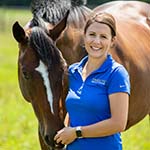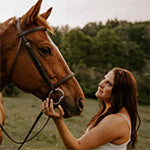Vitamin E is a crucial nutrient for horses, yet some horse owners don’t fully understand why it’s so important—especially during certain times of the year when natural sources become scarce.
This primary antioxidant plays a vital role in functions such as muscle recovery, neuromuscular health and overall well-being.
In this article, you’ll learn more about why Vitamin E intake changes with the seasons, which horses require higher levels and how to supplement it effectively.
The Role of Vitamin E in a Horse’s Body
Vitamin E is one of the most important antioxidants in a horse’s body, because it neutralizes free radicals that are produced during daily metabolic processes and exercise.
Free radicals, if not properly managed, can lead to muscle soreness, delayed recovery and cell damage. Vitamin E specifically prevents lipid oxidation. Lipid oxidation in horses can lead to oxidative stress, which can damage cells, proteins and DNA. This means Vitamin E is essential for functions like maintaining healthy cell membranes, supporting hormone production and serving as an energy source.
In addition to its antioxidant properties, Vitamin E plays a key role in neuromuscular function. Deficiencies in Vitamin E have been linked to conditions such as:
- Equine Neuroaxonal Dystrophy (eNAD)
- Equine Degenerative Myeloencephalopathy (EDM)
- Equine Motor Neuron Disease (EMND)
These disorders can cause significant muscular and neurological issues, some of which may be irreversible if they’re not caught early.
Seasonal Changes and Vitamin E Intake
The primary natural source of Vitamin E for horses comes from fresh, green pasture grass. However, as the seasons change, so does a horse’s ability to obtain sufficient amounts of this vital nutrient.
During the spring and summer months, high-quality pasture grass provides anywhere from 350 to 3,000 IU of Vitamin E per day. However, in the fall, pasture quality declines, and horses begin to rely more on forage sources like hay. Once winter arrives, most pastures go dormant, eliminating fresh grass as a viable Vitamin E source.
Hay, while a crucial source of fiber for horses, is not a reliable source of Vitamin E. Research shows that about 50% of Vitamin E content is lost within the first month after cutting and drying hay. After a few months of storage, hay contains little to no Vitamin E. This means that horses on a hay-based diet throughout the winter may require supplementation to maintain adequate levels during this season specifically.
Recommended Vitamin E Levels for Horses
The National Research Council (NRC, 2007) has established the following minimum Vitamin E requirements for a 1,100-pound horse:
- Idle Horses: 500 IU/day
- Light Work: 800 IU/day
- Heavy Work: 1,000 IU/day
However, recent studies suggest these recommendations may be on the low side, particularly for horses under stress or those with medical conditions requiring additional support.
Vitamin E deficiencies can present in various ways, though symptoms are often subtle. Horses with Vitamin E deficient myopathy may experience muscle atrophy and weakness, which can be reversed with proper supplementation. However, long-term deficiencies leading to neurological diseases like EMND or EDM often result in permanent damage.
Horses That Require Higher Levels of Vitamin E
While all horses need Vitamin E, certain horses have higher requirements due to their workload or health conditions such as:
Performance Horses:
Horses in consistent heavy exercise routines may need more Vitamin E to support muscle recovery and reduce oxidative stress. Equine nutritionists commonly recommend levels closer to 2,000 IU of Vitamin E per day for performance horses.
Horses with Neuromuscular Disorders:
Conditions such as PSSM (Polysaccharide Storage Myopathy), EPM (Equine Protozoal Myeloencephalitis), and other neurological disorders increase Vitamin E demand. 2,000 IU of Vitamin E per day or even higher levels for those with certain neurological conditions may be recommended by an equine nutritionist, depending on the individual horse’s needs. Horses diagnosed with EPM, for instance, may require up to 10,000 IU/day during treatment.
Broodmares and Young Horses:
Adequate Vitamin E intake during gestation and early life is critical for preventing developmental neurological disorders.
Horses on High-Fat Diets:
Since Vitamin E prevents lipid oxidation, horses consuming diets rich in fat may need additional supplementation.
Supplementing Vitamin E Effectively
Since Vitamin E can be measured accurately through blood tests, owners can monitor their horse’s levels before deciding on additional supplementation. If a deficiency is detected, it’s important to choose the right form of Vitamin E, as not all sources are equally bioavailable. Bioavailability refers to the amount of Vitamin E that is absorbed into a horse's bloodstream. Several factors influence Vitamin E bioavailability, including its form, the horse's age and its diet.
There are two primary forms of Vitamin E:
Natural Vitamin E (d-alpha-Tocopheryl Acetate):
This form is more bioavailable and is the preferred option for quickly increasing Vitamin E levels in deficient horses.
Synthetic Vitamin E (dl-alpha-Tocopheryl Acetate):
While slightly less bioavailable, synthetic Vitamin E remains stable in stored feeds and is an effective long-term supplement.
Many commercial horse feeds contain added Vitamin E, though the levels vary significantly, so be sure to check the levels listed on your horse’s feed bag. For example, Tribute’s Essential K® ration balancer provides 1,000 IU per pound, making it a suitable baseline supplement for most horses. Full-intake feeds like Tribute’s Kalm N’ EZ® also contain 1,000 IU per day at the minimum feeding rate, ensuring every horse receives the required levels without typically needing additional supplementation.
Can You Over-Supplement Vitamin E?
Vitamin E is generally safe, and toxicity is rare. The maximum safe level for horses is considered to be around 10,000 IU per day. However, excessive Vitamin E intake over long periods can interfere with the absorption of other essential nutrients, such as beta-carotene.
For horses requiring high doses due to medical conditions, regular bloodwork is recommended to ensure optimal levels are maintained without causing imbalances in other nutrients. For most horses, a daily intake between 4,000 to 5,000 IU is sufficient without any risk of toxicity.
Ensuring Optimal Equine Health: The Role of Vitamin E in a Balanced Diet
Although Vitamin E is a vital nutrient, it is only one component of a well-balanced equine nutrition plan. Ensuring that your horse receives a well-balanced diet tailored to their individual needs is key to their overall health and performance.
By understanding the importance of Vitamin E and supplementing it when necessary, you can help support your horse’s muscle function, neurological health and overall well-being—no matter the season.
If you have any concerns about your horse’s Vitamin E intake or overall feeding program, consider consulting with an equine nutrition specialist. Tribute® Superior Equine Nutrition offers free personalized feeding plans to ensure horses receive optimal levels of Vitamin E that meets the horse’s individual needs, as well as well-balanced nutrition.
If you have any questions about your horse’s feeding program, please reach out to us for a free personalized equine feeding plan.


